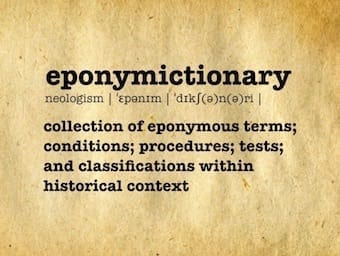John Langdon Down
John Langdon Haydon Langdon-Down (1828 - 1896) was an English
John Langdon Haydon Langdon-Down (1828 - 1896) was an English

Lachman test is a clinical test used to diagnose injury of the anterior cruciate ligament (ACL). Eponymised to John W Lachman, first described by GC Noulis

Technology is good for learning, but technology is bad for learning. Spot the difference and have a personal strategy to make a difference

John W Lachman (1919 – 2007) was an American Orthopedic Surgeon. Eponymously associated with the Lachman test of knee ligament stability

Mary Frances Lyon (1925–2014) was an English geneticist, best known for her discovery of X-chromosome inactivation. Lyonisation.
Biography Born August 2, 1924 in Lima, Peru 1951 – Bachelors degree in medicine, Universidad Mayor de San Marcos 1959 – MD, Universidad Mayor de San Marcos 1961 – Co-founded the Universidad Peruana Cayetano Heredia 1963-1965 Minister of Public Health,…
Biography Born 1 May 1852, Petilla de Aragón, Spain 1906 – Nobel Prize in Physiology or Medicine Died 17 October 1934, Madrid, Spain Medical Eponyms Anatomical eponyms Major Publications Ramón y Cajal S. Manual de histología normal y técnica micrográfica.…
Henry Hubert Turner (1892 - 1970) was an American endocrinologist. Remembered for Turner syndrome and description in 1938
Biography Born Died Medical Eponyms Key Medical Contributions Major Publications Controversies References Bibliography. Clara, Max 1899-1966. WorldCat Identities Buttner R, Lee J. De-eponymising anatomical terminology. 2020

January 2020 Adult Emergency Medicine Chest X-ray interpretation with Alyssa Thomas, MD and Claire Milam, MD

The SMACC 2019 Opening Ceremony The SMACC Opening Ceremony is an integral part of the conference welcoming delegates to an educational experience unlike any other. Inspiration for SMACC Sydney included the inverted triangle: the alchemical symbol for water which is…
Biography Born 12 March 1649 Died 1713 Medical Eponyms Key Medical Attributions Fingerprints – papillary ridges (1685) Major Publications Published under Godefridum Bidloo; Govard Bidloo; Godefridi Bidloo Bidloo G. Anatomia humani corporis, centum & quinque tabulis, per artificiossis. G. de…